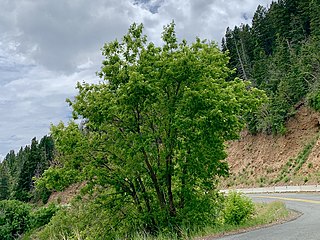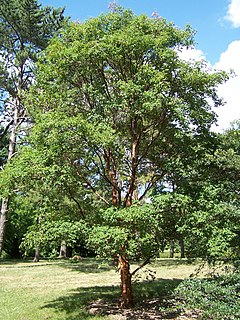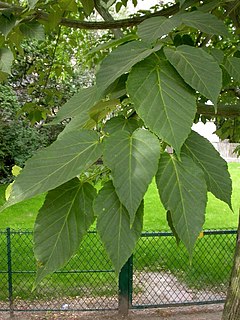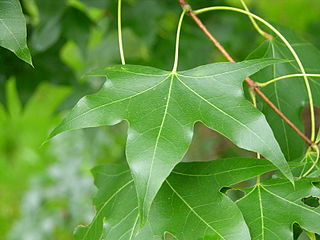
Acer campestre, known as the field maple, is a flowering plant species in the family Sapindaceae. It is native to much of continental Europe, Britain, southwest Asia from Turkey to the Caucasus, and north Africa in the Atlas Mountains. It has been widely planted, and is introduced outside its native range in Europe and areas of USA and Western Australia with suitable climate.

Acer negundo, the box elder, boxelder maple, Manitoba maple or ash-leaved maple, is a species of maple native to North America. It is a fast-growing, short-lived tree with opposite, compound leaves. It is sometimes considered a weedy or invasive species, and has been introduced to and naturalized throughout much of the world, including in South America, Australia, New Zealand, South Africa, much of Europe, and parts of Asia.

Acer griseum, the paperbark maple or blood-bark marple, is a species of flowering plant in the family Sapindaceae, native to central China. Acer griseum is found in the Chinese provinces of Gansu, Henan, Hubei, Hunan, Shaanxi, Shanxi and Sichuan, at altitudes of 1,500–2,000 m (4,921–6,562 ft).

Acer ginnala, the Amur maple, is a plant species with woody stems native to northeastern Asia from easternmost Mongolia east to Korea and Japan, and north to the Russian Far East in the Amur River valley. It is a small maple with deciduous leaves that is sometimes grown as a garden subject or boulevard tree.

Acer tataricum, the Tatar maple or Tatarian maple, is a species of maple widespread across central and southeastern Europe and temperate Asia, from Austria and Turkey east as far as Japan and the Russian Far East. The species is named after the Tatar peoples of southern Russia; the tree's name is similarly commonly also misspelled "Tartar" or "Tartarian" in English.

Acer japonicum, the Amur maple, downy Japanese-maple or fullmoon maple, is a species of maple native to Japan, on Honshū, Hokkaidō, Kyūshū, and also southern Korea.

Acer triflorum, the three-flowered maple, is a species of maple native to hills of northeastern China and Korea.

Acer maximowiczianum, is a species of maple widely distributed in China and Japan.

Acer monspessulanum, the Montpellier maple, is a species of maple native to the Mediterranean region from Morocco and Portugal in the west, to Turkey, Syria, Lebanon, and Israel in the east, and north to the Jura Mountains in France and the Eifel in Germany.

Acer laevigatum, the smooth maple or Nepal maple, is an atypical species of maple native to southern China, northern India, northern Myanmar, Nepal, and northern Vietnam. It grows at moderate altitudes of 1,000-2,000 m, with a wet monsoon climate.

Acer davidii, or Père David's maple, is a species of maple in the snakebark maple group. It is native to China, from Jiangsu south to Fujian and Guangdong, and west to southeastern Gansu and Yunnan.

Acer sieboldianum is a species of maple native to Japan and common in the forests of Hokkaidō, Honshū, Shikoku and Kyūshū Islands; in the south of the range it is restricted to mountain forests. It is named after Philipp Franz von Siebold.

Acer cissifolium is a maple native to Japan, from southern Hokkaidō south through Honshū and Shikoku to Kyūshū.

Acer truncatum, the Shantung maple, Shandong maple, or purpleblow maple, is a maple native to northern China, in the provinces of Gansu, Hebei, Henan, Jiangsu, Jilin, Liaoning, Inner Mongolia, Shaanxi, Shandong, Shanxi, and to Korea.
Acer duplicatoserratum is a species of maple, native to southern and eastern mainland China and Taiwan.
Acer leipoense is a species of maple, endemic to southwestern Sichuan in southwestern China. It is an endangered species, growing at altitudes of 2,000–2,700 m.
Acer miaotaiense is a species of maple endemic to China. It grows in mixed forests of southeastern Gansu, southwestern Henan, northwestern Hubei, southern Shaanxi, and Zhejiang.

Acer miyabei is a species of maple native to Japan, where it occurs in Hokkaidō and the Tōhoku region in northern Honshū.

Acer tegmentosum, the Manchurian striped maple, is a species of deciduous tree in the maple genus, which is native to the southern part of the Russian Far East, northeastern China, and Korea.
Acer caesium is an Asian species of maple found in India, Pakistan, Nepal, and China.
















